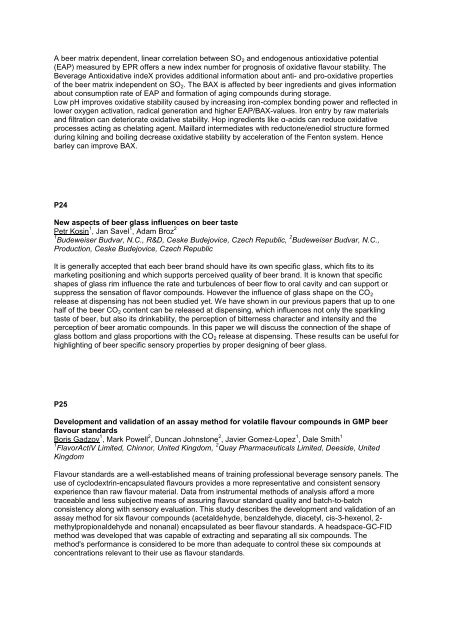here - the 34th European Brewery Convention
here - the 34th European Brewery Convention
here - the 34th European Brewery Convention
You also want an ePaper? Increase the reach of your titles
YUMPU automatically turns print PDFs into web optimized ePapers that Google loves.
A beer matrix dependent, linear correlation between SO 2 and endogenous antioxidative potential<br />
(EAP) measured by EPR offers a new index number for prognosis of oxidative flavour stability. The<br />
Beverage Antioxidative indeX provides additional information about anti- and pro-oxidative properties<br />
of <strong>the</strong> beer matrix independent on SO 2 . The BAX is affected by beer ingredients and gives information<br />
about consumption rate of EAP and formation of aging compounds during storage.<br />
Low pH improves oxidative stability caused by increasing iron-complex bonding power and reflected in<br />
lower oxygen activation, radical generation and higher EAP/BAX-values. Iron entry by raw materials<br />
and filtration can deteriorate oxidative stability. Hop ingredients like α-acids can reduce oxidative<br />
processes acting as chelating agent. Maillard intermediates with reductone/enediol structure formed<br />
during kilning and boiling decrease oxidative stability by acceleration of <strong>the</strong> Fenton system. Hence<br />
barley can improve BAX.<br />
P24<br />
New aspects of beer glass influences on beer taste<br />
Petr Kosin 1 , Jan Savel 1 , Adam Broz 2<br />
1 Budeweiser Budvar, N.C., R&D, Ceske Budejovice, Czech Republic, 2 Budeweiser Budvar, N.C.,<br />
Production, Ceske Budejovice, Czech Republic<br />
It is generally accepted that each beer brand should have its own specific glass, which fits to its<br />
marketing positioning and which supports perceived quality of beer brand. It is known that specific<br />
shapes of glass rim influence <strong>the</strong> rate and turbulences of beer flow to oral cavity and can support or<br />
suppress <strong>the</strong> sensation of flavor compounds. However <strong>the</strong> influence of glass shape on <strong>the</strong> CO 2<br />
release at dispensing has not been studied yet. We have shown in our previous papers that up to one<br />
half of <strong>the</strong> beer CO 2 content can be released at dispensing, which influences not only <strong>the</strong> sparkling<br />
taste of beer, but also its drinkability, <strong>the</strong> perception of bitterness character and intensity and <strong>the</strong><br />
perception of beer aromatic compounds. In this paper we will discuss <strong>the</strong> connection of <strong>the</strong> shape of<br />
glass bottom and glass proportions with <strong>the</strong> CO 2 release at dispensing. These results can be useful for<br />
highlighting of beer specific sensory properties by proper designing of beer glass.<br />
P25<br />
Development and validation of an assay method for volatile flavour compounds in GMP beer<br />
flavour standards<br />
Boris Gadzov 1 , Mark Powell 2 , Duncan Johnstone 2 , Javier Gomez-Lopez 1 , Dale Smith 1<br />
1 FlavorActiV Limited, Chinnor, United Kingdom, 2 Quay Pharmaceuticals Limited, Deeside, United<br />
Kingdom<br />
Flavour standards are a well-established means of training professional beverage sensory panels. The<br />
use of cyclodextrin-encapsulated flavours provides a more representative and consistent sensory<br />
experience than raw flavour material. Data from instrumental methods of analysis afford a more<br />
traceable and less subjective means of assuring flavour standard quality and batch-to-batch<br />
consistency along with sensory evaluation. This study describes <strong>the</strong> development and validation of an<br />
assay method for six flavour compounds (acetaldehyde, benzaldehyde, diacetyl, cis-3-hexenol, 2-<br />
methylpropionaldehyde and nonanal) encapsulated as beer flavour standards. A headspace-GC-FID<br />
method was developed that was capable of extracting and separating all six compounds. The<br />
method's performance is considered to be more than adequate to control <strong>the</strong>se six compounds at<br />
concentrations relevant to <strong>the</strong>ir use as flavour standards.





